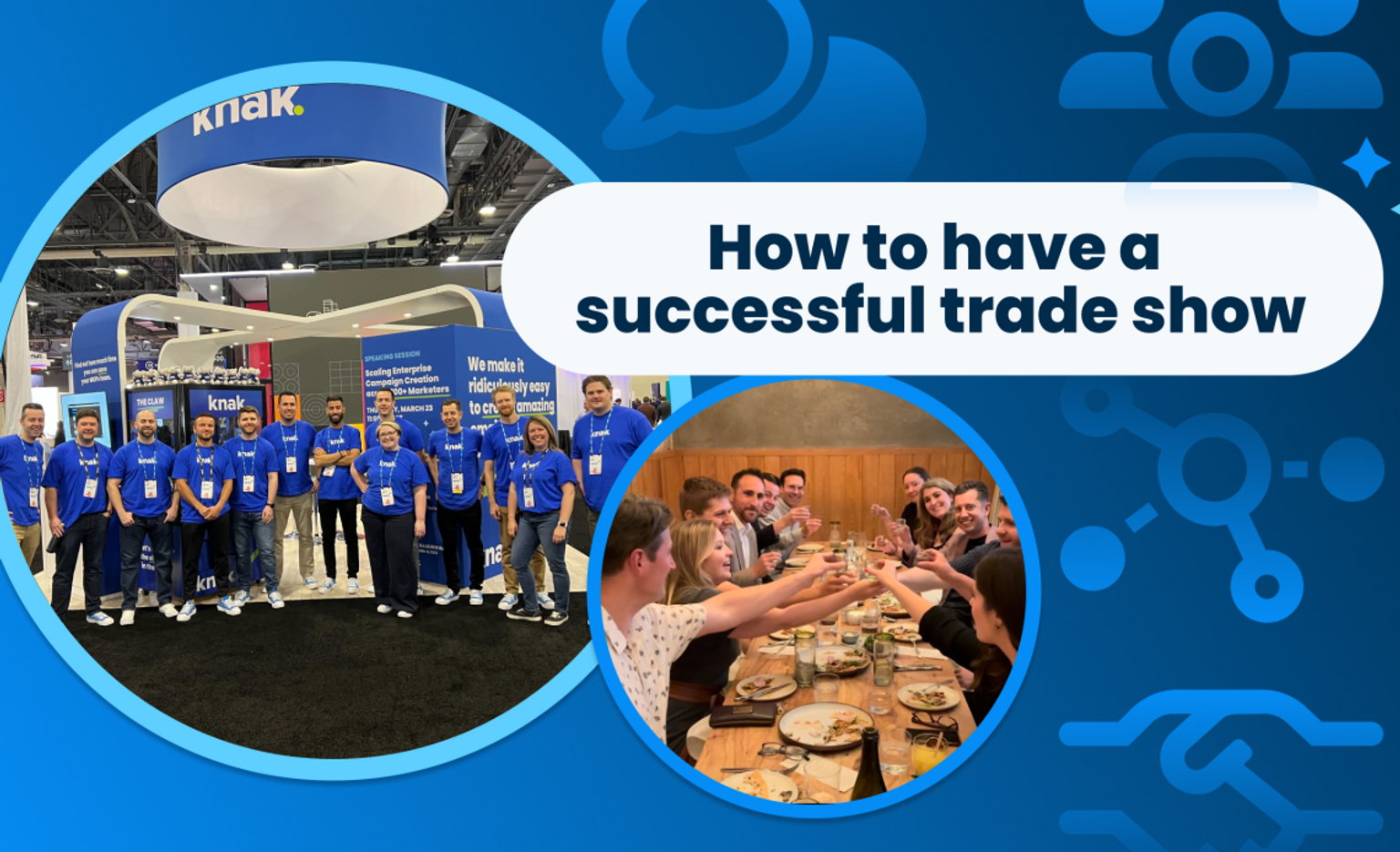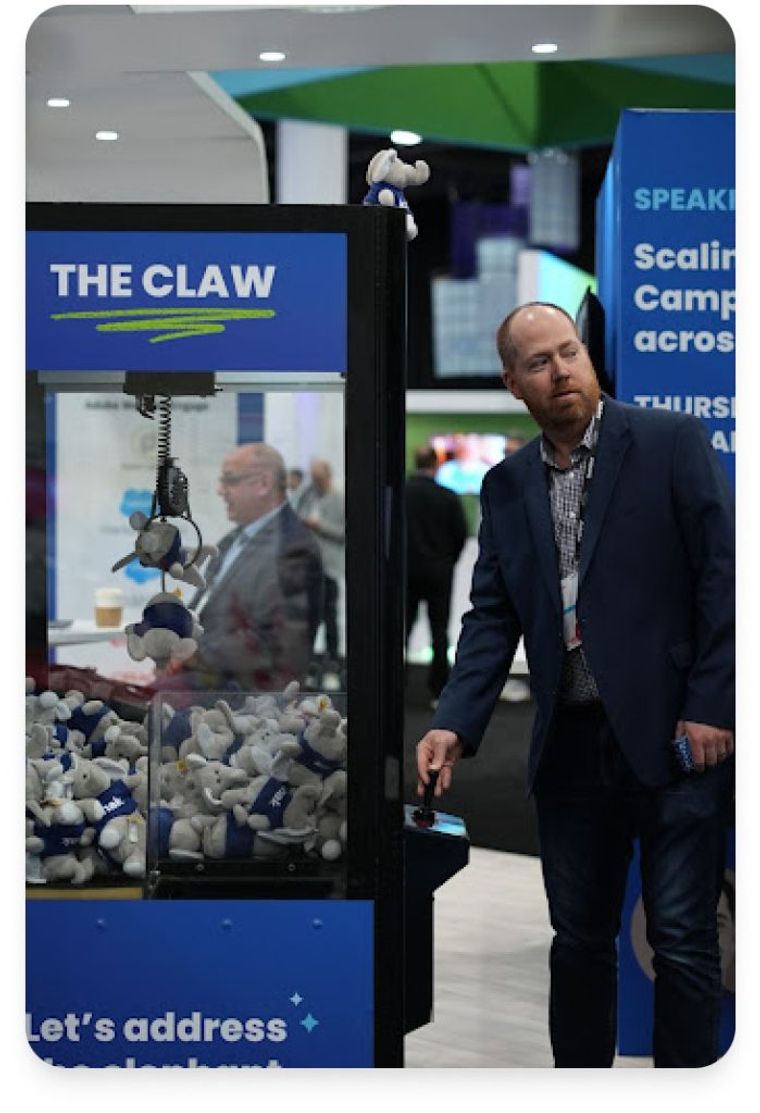How to have a successful trade show

Summary
Maximize trade show success with Knak's insights: From choosing the right event to creative booth strategies, turn your next show into a triumph.
We recently came back from an intense few days at the Adobe Summit business conference in Las Vegas.
I’ve been attending this annual conference for years (it was held virtually during the pandemic) and I know from experience that it’s a great way to drum up new business.
For a seller, taking part in a trade show like this is not cheap. We spent over $200,000 to attend the Adobe Summit this year – an amount which, in some cities, is enough to buy a house.
We spend the money because it’s worth it, and we expect to get a good return on our investment.
Nevertheless, at that price the stakes are high. That’s why I want to share what I’ve learned about getting the most out of a trade show like the Adobe Summit.
Find out where your buyers are
There are many trade shows out there, and they can be very attractive because of the speakers, the learning opportunities or even the location of the conference.
But if you’re looking to sell your product or service, the first thing you need to determine is whether your buyers will be there.
How do you know?
Past experience is a good indicator, so if you go to a trade show one year and find it useful, chances are you should go back.
You can also study the prospectus conference organizers send out.
And you should talk to current customers (and prospective ones) to find out where they’re going.
When I first started going to the Adobe Summit as a marketer, I was my own ideal buyer of Knak. I knew all of my peers went to the show, so after we started Knak I knew from experience that we would find customers there. That’s why we have such a big presence at the Adobe Summit.
Decide on a participation strategy
Once you have decided which show to attend, you need to decide how to make the most of your presence.
The typical way to participate is to have a booth in the exhibition hall, but there are other options. The option you choose depends on your budget, how many people you will have at the conference and what your objectives are.
Take the booth option, which is what we chose to do this year because we know it works for us.
Booths can be large or small, well-located in high-traffic areas or off on the side. The more money you are willing to fork out, the bigger the booth you can get, and the better location you will have.
See if you can find out where your competitors are located and what size of booth they’re getting. You don’t want to be in the cheapest booth if your competitor is in the biggest.
If you don’t want a booth, there are other options.
Revenue Pulse, my other company, chose not to have a booth in the expo hall. Instead, they rented a suite at the conference venue and held events there. I’ve seen other companies hold events off-site, for example in a bookstore or a restaurant.
Don’t be afraid to get creative.

In addition to renting a suite, Revenue Pulse did something brilliant this year. They had a guy dressed in a branded astronaut suit wander around the conference. That got them a lot of exposure for a small amount of money.
Guerilla marketing tactics can be pretty wild, and they can also be incredibly effective.
For example, in 2000 a fake protest staged by Salesforce at a competitor’s conference is widely credited with helping jumpstart the company.
Whatever you decide, the important thing is to have a participation strategy.
Have something that draws people to your booth
If you have a booth, you need a hook to draw people in.
There are all sorts of possibilities. You can hold a contest, offer food, have comfy chairs for people to rest in, or bring in a celebrity people want to meet.

This year, we set up a claw machine in our booth and invited passersby to use it to see if they could get a prize – a stuffed animal with a Knak T-shirt.
It worked! We got lots of people to stop!
Don’t be afraid to be ‘over the top’ in guerilla marketing tactics or in gimmicks for drawing people into your booth. Outrageous and tacky actually work. This is a trade show, not real life.
Make sure your booth is on-brand
People at a trade show are bombarded with information, so your booth has to be designed in such a way that it gets right to point about who you are and what you do.
Your logo and corporate colours have to be front and centre, and any written information has to make it blindingly clear – in as few words as possible – what it is you do. Don’t use too much text. You don’t need to tell your life story with your booth; tell people the main thing, and no more. If they’re interested in how you came to be, they’ll ask you.

Have something for visitors to take away
At your booth, you will want to have something people can take with them so they can remember your brand.
This is a challenge. Most people today travel with carry-on baggage only, so any swag you give out can’t be too big.
It’s best to have something that’s small – and useful.
This year we gave out branded tubes of lip balm. (It’s hot and dry in Las Vegas, so lip balm met a need). We also had branded Bluetooth luggage trackers, a popular & useful piece of tech.
The stuffed animals in our claw machine also filled a need. A significant number of show attendees have young children and, as every parent knows, the kids always want you to bring something back from a business trip.
The stuffed animals saved many people from having to make a last-minute visit to the airport gift shop on the way home.
Make sure people at your booth are trained and dressed appropriately
The people staffing your booth represent your company. You need to put some thought into how they present themselves.
That means guidelines for how people staffing your booth should dress. At the very least, everyone should dress in the same general style and colour. You don’t want one employee in a tank top and another one wearing a tie and jacket, or five people in black T-shirts and two in pink polo shirts.
You can take things one step further and get special clothing made.
We, for example, got branded T-shirts made for everyone.
I like T-shirts for us because we’re a tech company and they fit with our image. T-shirts are also non-threatening and casual, and make us more approachable. (We also got our employees custom-made Knak shoes this year as a little extra.)
One more thing about what to wear. Your conference badge will be hanging from a lanyard with someone else’s logo on it. We ditched the standard-issue lanyards and got branded lanyards of our own.
As to staffing the booth, you will want a mix of types. You need very outgoing personalities to bring people in, and technical people who, once people are in the booth, can talk knowledgeably about your product or service.
It’s wise to train your staff in advance, for example by giving them a list of questions they should be asking visitors. This will help them identify visitors’ pain points and focus the discussion on how your product or service can address their issues.
In fact, when people ask me what Knak does, I don’t give a stock answer; instead I ask them questions and tailor my response to their needs. Someone in marketing operations will get one take on Knak, an email developer will get another.
So ditch the elevator pitch; for best results you need to personalize your approach.
One final tip about expo hall discussions: Sometimes, you will realize that the person you are talking to is not one you should be talking to. Maybe you’re chatting with someone in finance when you really want the person in marketing. All is not lost; just see if you can get the person in finance to introduce you to the person in marketing.
Show your existing customers you value them
A lot of your existing customers will be at the show. Don’t ignore them. I strongly recommend organizing an event – a dinner, for example – just for them. And if you can include prospects at the dinner, even better; your existing customers will do your marketing for you.

If you’re looking to keep costs down, have the dinner off-site; it will probably be cheaper. In Las Vegas, for example, you can find great restaurants off the strip that cost much less than centrally located ones.
Plan for debrief and follow-through
Talk to a lot of prospects at the trade show? Good. Now make sure you have a plan to follow through.
We start the moment the exhibition hall floor closes by getting everyone who was at the booth into a room and going through all the leads. We’ve been scanning visitors’ badges so we know who we talked to; our VP Sales will lead the discussion and try to gather information that will allow us to target our follow-up and next steps.

Don’t wait to do this. Sure, everyone is tired at the end of the show. But in a few days they will have forgotten a lot of important information. So act quickly!
Learn what works and what doesn’t
Given the investment people make in trade shows, there’s a lot of pressure to make participation a success.
You won’t get it right the first time, so don’t be too hard on yourself. If you find something doesn’t work well one year, make a note of it and see if you can do better next time.
But do work at making it better. A good trade show can pay off handsomely, so it’s worth trying consciously to improve from year to year.
The bottom line is this: Trade shows are great; talking to leads is great; and coming back with leads is great. But what really matters is converting the excitement of a trade show into business. Real business.
You’ll know it’s been worth it when you are able to see the results.
Pierce Ujjainwalla (@marketing_101 on Twitter) is an entrepreneur, career marketer and founder of @revenuepulse and @knak. Marketing is his jam; doing it better with technology is his passion.

Author
Co-founder & CEO, Knak
Pierce is a career marketer who has lived in the marketing trenches at companies like IBM, SAP, NVIDIA, and Marketo. He launched Knak in 2015 as a platform designed to help Marketers simplify email creation. He is also the founder of Revenue Pulse, a marketing operations consultancy.











